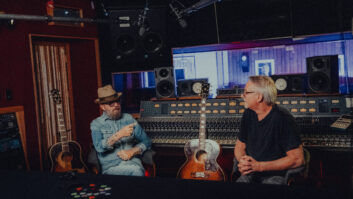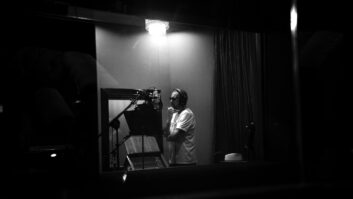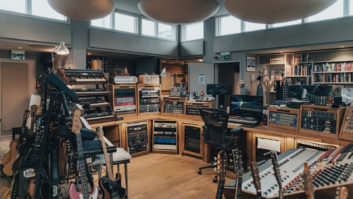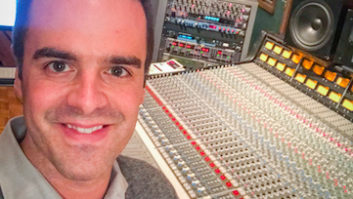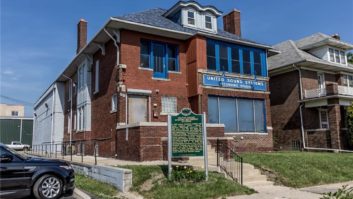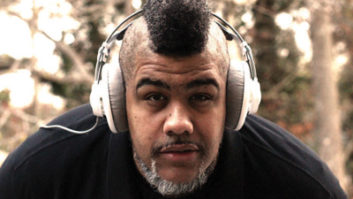
With three acclaimed solo albums and more than 12 million in sales to her credit, pop singer Annie Lennox must have been waiting for just the right time and the right album with which to launch her first solo tour. She found it with Bare, Lennox’s first collection of original material in more than a decade, released June 10 on J Records. Though it’s been four years since her reunion with Eurythmics partner Dave Stewart on the 1999 album Peace, and eight years since her last solo album — the covers collection Medusa — hit stores, Lennox’s rich, distinctive alto hasn’t lost one decibel of power or character. The same holds true onstage, where she entertained large crowds of expectant fans during a month-long, consistently sold-out U.S. tour.
Backed by a full ensemble that included keyboardists Bernie Smith and Adam Wakeman, guitarist Tony Remy, bassist Paul Turner, drummer Steve Barney, and backing vocalists Beverley Skeete, Claudia Fontaine and Carol Ken- yon, Lennox danced her way through a set that included a number of old favorites. Some of the highlights were “I Need a Man,” “Walking on Broken Glass” and a call-and-response rendition of “Sisters Are Doing It for Themselves.”
SOMETHING SO RIGHT
The platinum-blonde chameleon — who morphed from a slouchy beatnik to a feminine sophisticate in a shimmering top and strappy heels during the course of an evening — rounded out her single-encore set with a series of piano ballads and acoustic numbers accompanied by a pared-down band. Her choice of sonically pristine symphony halls and performance theaters not only complemented her elegant mix of contemporary pop and vintage soul, but also provided daily challenges for FOH engineer Jim Ebdon and monitor engineer Tim Paterson.

Ebdon, who recently handled live sound for Sting and the American Idol tour, had just finished a six-month stint with Aerosmith when he got the call to serve on the Lennox tour. Paterson, whose credits include jazz phenom Herbie Hancock, among others, had just wrapped up a tour with Cream bassist Jack Bruce before meeting up with the former Eurythmic. Needless to say, both parties experienced a dramatic switch in musical genre and venue, but adapted well to their new environment.
Prestigious rooms such as Chicago’s Shubert Theatre, Toronto’s Center for the Arts, San Diego’s Copley Symphony Hall and New York’s Apollo Theatre vary dramatically in size and character, each offering unique hurdles to cross in terms of preparing for an amplified music event. “In an arena, the same amount of P.A. goes up and you’re exactly the same distance from the stage each time,” says Ebdon after soundcheck at San Francisco’s Orpheum Theatre. “This is more of a challenge, but it’s very rewarding.”
LAYERS OF CONTROL
Ebdon travels with the DiGiCo D5 digital console, a lightweight, compact 64-channel board designed by Soundtracs. The 24-bit audio board interfaces with the stage inputs through a proprietary fiber-optic network that allows for cable runs of up to 100 meters. “Being a completely digital work surface, the DiGiCo has complete memory recall and memory reset,” Ebdon says. “We can run the fiber-optic cable from a box onstage out to the console, so there’s no thick cables anymore, which is great. And the quality’s fantastic.”
The console’s small size makes it easier for Ebdon to set up shop in venues that are unaccustomed to holding expansive mixing desks, large loudspeaker setups and elaborate lighting systems. “Had we brought a traditional analog console, it would have been a headache,” Ebdon confides. “With this tiny little thing, I’ve got three small racks, the desk and that’s it. My total footprint’s about six-feet-by-six-feet.”
Ebdon, who worked as a studio engineer at Surrey Sound (recording home of The Police) for nine years before moving into live sound, first used the DiGiCo during Lennox’s two-week rehearsal in London. He learned the board in a matter of hours, he says, and liked it so much that he bought one. The versatile engineer uses minimal outboard gear, relying mostly on the console for EQ and other effects. He does, however, travel with a Focusrite ISA 430 Producer Pack and BSS 901 compressor for use on Lennox’s vocals. “She has a very dynamic vocal, and I like to compress the high mids in her voice,” he explains.
Ebdon needed a microphone that wouldn’t alter the distinct character of Lennox’s voice and found that the Audio-Technica 4054 fit the bill. “It’s a good-quality microphone and doesn’t color the sound at all,” he says.
Audio-Technica’s 4050 microphones captured the drums, electric and upright bass, and acoustic and electric guitar. The backing vocalists sang through Sennheiser 90s during the tour’s U.S. leg, but Ebdon plans to switch to an Audio-Technica model for the UK dates. Neumann and AKG mics provided additional support. Mackie SDR-24 hard disk recorders took care of the minimal drum loops and sampled keyboard parts for Lennox’s set. Loops found their way into only half-a-dozen songs, and prerecorded keyboard parts were incorporated in very few spots on the mostly live performance.
CUSTOM-TAILORED
Ebdon mixed the show at a reasonably low volume, saving the ears of thousands of Lennox fans and preserving the venue’s integrity at the same time. “There are a couple of loud moments, but, primarily, it’s a quiet show,” Ebdon says. “When it’s just Annie and the piano, you can hear a pin drop.” The Clair Bros. P.A. and I-4 line array system provide sonic support.
“A lot of people said to me, ‘Oh, you’re taking the I-4 on a theater tour? You must be mad,’” Ebdon recalls. “But it’s actually worked quite well. I’ve used this system in arenas, but it was with the old crossovers. This is a completely new P.A. now, and I’m glad I got to have a go with it.”
The Clair I/O loudspeaker controller, manufactured by Lake Technologies, works in tandem with the I-4 system to allow the user to control all P.A. parameters according to the venue’s characteristics. With the aid of a wireless computer, the user can walk around the room and adjust the EQ curve and delays, ensuring consistent sound quality for every seat in the house. “We can really fine-tune the P.A.,” he says. “It’s actually one of the best pieces of audio equipment I’ve seen in a long time.”
At the Orpheum Theatre, the system P.A. included two 5° and four 10° cabinets per side, two Clair I-4 B bass cabinets and two S-4 subwoofers per side, and a series of P2s to cover the outer reaches. Ebdon and Paterson — along with Clair Bros. reps Chris Fulton, Andy Sottile and Greg Hall — flew four cabinets and stacked two on each side of the stage to compensate for the low balcony.
FRONT AND CENTER
Paterson mixes on the popular Midas Heritage 3000, adjusting levels on six Senn- heiser 3000 Series wireless in-ear monitors and a complement of Clair/ShowCo SRM wedges. Mindfulness plays a key role when working with various systems simultaneously, according to Paterson. “You’ve got to be very aware of how much you give people with the levels of anything,” Paterson says. “The best way to get around that is to listen to every mix as you change things. It makes life harder, but it’s worth doing.”
After nearly 20 years with Eurythmics and over a decade on her own, the Grammy-nominated singer certainly has the right to a specific monitor mix, but her preference comes from a desire for excellence, rather than the stereotypical diva-esque attitude of a high-profile pop star. With an abundance of adoring fans, critical acclaim and a respected Billboard Century Award to her credit, Lennox remains humble and reportedly experiences bouts of anxiety at the thought of a live piano vocal. “She writes at the piano, but she had never played a piano onstage,” Paterson says. “It’s great that she had the confidence to do it, and she has the confidence in us to make it sound good.”
Heather Johnson is a freelance writer based in the San Francisco Bay Area.
